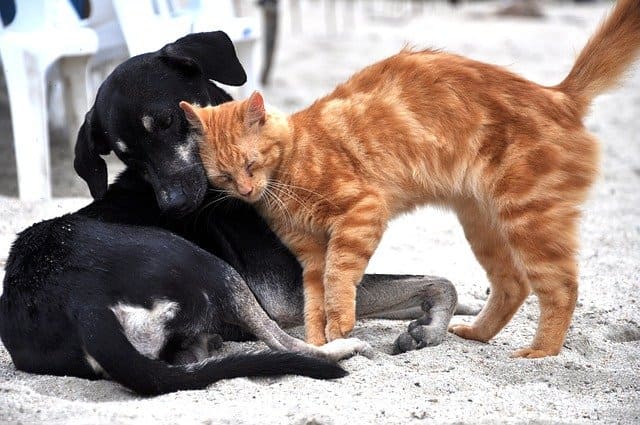
5. Failing to understand the importance of spaying or neutering your new pet
All of the animal shelters, humane society groups, and veterinarians will inform people that it’s vital to spay or neuter your pet when they get of the right age. Don’t believe the old argument that it makes them gain weight or it’s cruel to stop them from having babies. Spaying and neutering pets is the top method of making sure they live longer and stay healthier.
Pets that aren’t spayed or neutered can get diseases like testicular or ovarian cancer. Plus they are prone to roam around, fight or can spray urine to mark territory all over the house. Make sure you stay a part of the solution to stop these things! Sometimes pets adopted from shelters or rescue groups are fixed prior to you getting them or they might make you sign an agreement to get it done when they are old enough.
If you got your pet a different way, talk to your vet on getting them spayed or neutered or see if your local animals shelter has free or lower cost options.
4. Quitting too fast when you get another pet to add to your home
When you add a new pet to the household and you already have a dog or cat, it could cause initial issues that are seemingly alarming. You have to be ready for lots of hisses, spitting, or growls when they meet for the first time. That goes double if you rush the meeting.
Don’t forget that the top method of introducing animals is through smelling them prior to seeing them. If you are introducing cats, give each a blanket to sleep with for a few days (not in the same room) and then switch it up and give the cats each other’s blankets. This way they learn the scent of the other cat. You can also brush one of the cats, then use the same brush to groom your other cat. Plus, start letting one cat roam around the house, then put him in another room and let the new cat roam around the house. Both will need lots of assurance too, and you have to introduce them physically very slowly and always have lots of patience. Use the pace they seem to need and don’t rush it.
If you are introducing your dog to a new cat, you must always keep the dog hooked to a leash. It’s best for one person to have the dog and one the cat. Don’t let the dog chase your new cat. Make sure the cat has a place to get away if it needs to. If the dog gets aggressive, then correct it immediately and don’t ever let them be alone together. Make sure the dog is 100 percent not going to hurt the cat prior to letting them be together without supervision.
3. Not accepting the reality that urine accidents will happen
Some people may get upset to hear it, but you must understand that animals are going to pee on things and have accidents! Likely it is going to happen on your rug and not somewhere easy to clean like tile or it could be right on your fancy heels instead of your trashy tennis shoes.
If you properly train a pet it is more likely to not have such accidents, but they still occur. Even well trained pets have accidents or could be sick and pee somewhere inappropriate.
When it comes to cats, ensure you clean their litter boxes daily or they will probably look for a cleaner spot to do their business. Get one box for each cat. If you have a dog, be sure to put together some sort of schedule and if you work, be sure someone comes by to take the dog out to go to the bathroom a few times a day. Be aware that new pets are nervous and could have accidents or if they get sick or stressed it could happen too. If it keeps occurring, be sure to get them checked out by your vet to rule out a urinary infection.
2. Not ensuring the house is pet friendly
Lots of things can mean danger for your pet such as blue toilet water, tinsel on a Christmas tree, extension cords, bottles of glue or other chemicals, blinds in windows, or even some types of plants are poisonous to pets. Plus things like string, or caps from bottles or even a pair of undies could spell death for your pet! Make sure you think hard on what a pet might think is tasty or interesting that could instead be dangerous. Get down on the floor and look it over carefully. Make sure all the possible bad scenarios is resolved. It is similar to baby proofing your house!
Don’t leave pills where your pet could eat them and if your cat likes to knock stuff off the counters or tables, your dog will indeed chew it up! Get familiar with the things that are poison to pets like certain types of human food and certain plants then get rid of them or keep them high up where the pet can’t reach them. Don’t let your guests feed them scraps or bones from the table either!
1. Knowing resources necessary to raise pets
Pets are shown to make your life better and can even help protect humans from the odds of getting a heart attack or depression. They provide companionship, they are funny, and they help you get rid of stress, sadness and even give more purpose to your life. They provide unconditional love and that’s hard to come by these days.
So, be ready to provide the best for your pets. Know what it costs to raise these furry creatures. If you add up the costs of adopting them, getting them required shots, food, flea and tick control, veterinarian costs, grooming items, beds, etc., you can expect to end up paying between $4,500 to a little over $18,000 if your cat lives to be 14 years old and between about $4,000 and nearly $39,000 to raise a dog to that age.


